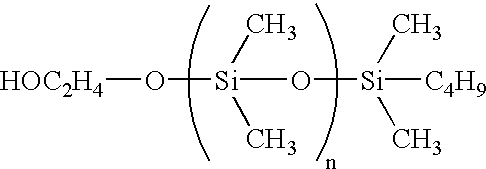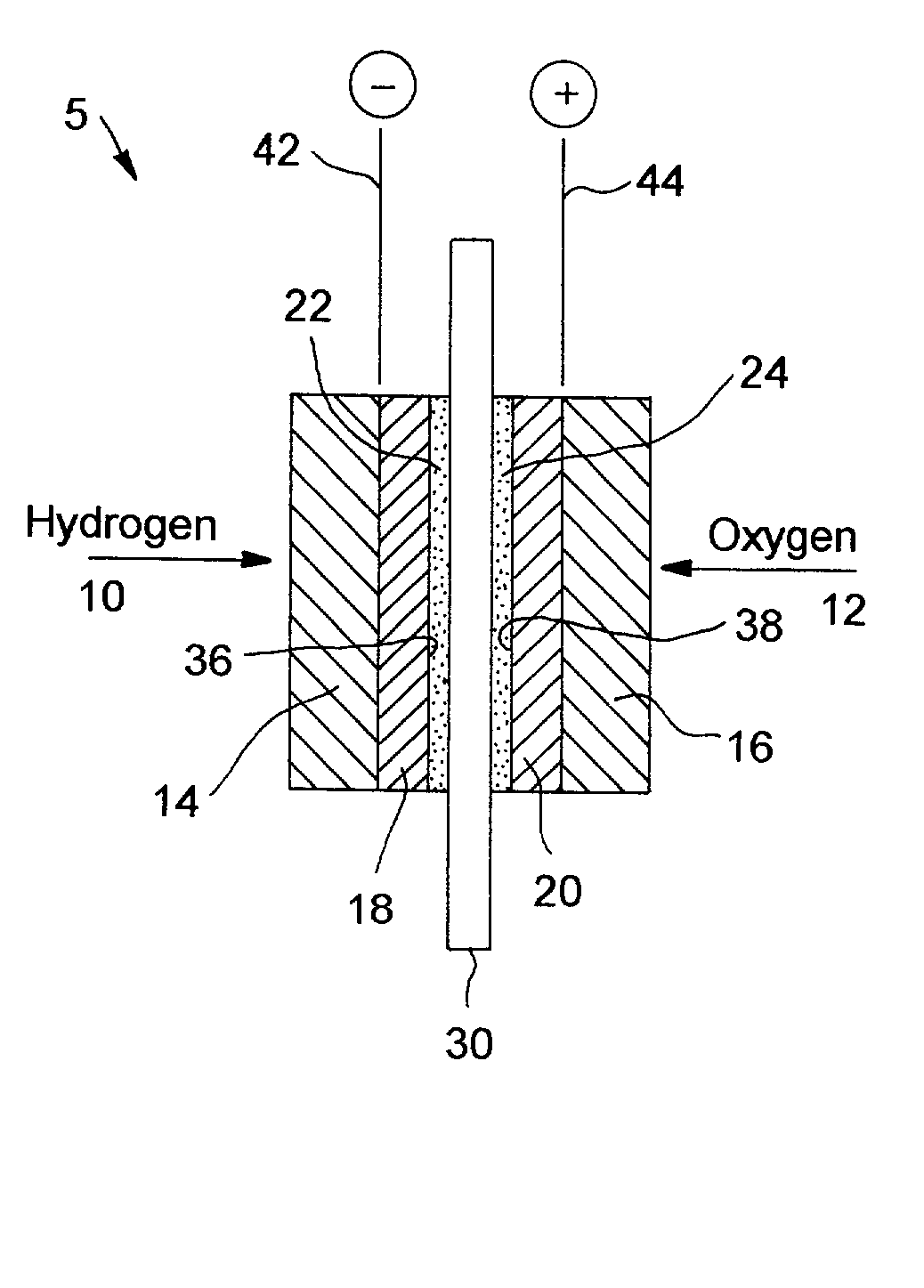Fuel cells and other products containing modified carbon products
a technology of carbon products and fuel cells, which is applied in the direction of cell components, metal/metal-oxide/metal-hydroxide catalysts, physical/chemical process catalysts, etc., can solve the problems of difficult creation of three-dimensional reaction zones on electrodes in contact with electrolyte, and achieve the reduction of catalyst efficiency, poor catalyst utilization, and electrode performance.
- Summary
- Abstract
- Description
- Claims
- Application Information
AI Technical Summary
Benefits of technology
Problems solved by technology
Method used
Image
Examples
example 1
[0093] Five membrane electrode assemblies (MEA's) were constructed. The reagents used were Pt black and 20 weight % Pt on VULCAN XC 72 carbon black (both from Alfa Aesar), Teflon PTFE 30 dispersion (DuPont) containing 60 weight % PTFE, hydrophobic Toray paper (Toray), Nafion 117 membrane (DuPont), Nafion solution, 5 weight % (Electrochem, Inc.) and Kynar 721 polyvinylidene fluoride powder (AtoFina). All MEA's were fabricated with a Nafion 117 membrane and an anode that consisted of 4.0 mg Pt black / cm.sup.2. Four MEA's were constructed using a standard procedure wherein the supported catalyst was bonded with PTFE. In these cases, a dispersion consisting of 90 parts of the supported Pt catalyst and 10 parts PTFE was mixed by sonification, flocculated by acidification to pH 3, and dried at 105.degree. C. The powder was then deposited on the 2 hydrophobic Toray paper to form a catalyst layer containing 0.5 mg Pt / cm.sup.2. The catalyst layer was heated at 360.degree. C. for 30 minutes to...
example 2
[0138] BLACK PEARLS 2000 carbon black, 50 g, was diazotized with sulfanilic acid (about 25 g), resulting in the attachment of a high level of --C.sub.6H.sub.4SO.sub.3Na groups. The resulting dispersion was diafiltered to remove the reaction byproducts and then passed through a cation exchange column, in its hydrogen form, to replace the Na.sup.+ in the attached group with H.sup.+ (i.e., forming --C.sub.6H.sub.4SO.sub.3H groups). A solid product was obtained after drying the dispersion at 75.degree. C. To an aqueous dispersion of the treated black (2 to 5 g), a solution of either [Pt(NH.sub.3).sub.4](OH).sub.2 or [Pt(NH.sub.3).sub.4]Cl.sub.2 was added to achieve Pt loadings of either about 1 mmoles / g treated black or 0.65 mmoles / g treated black, respectively. The resulting products were dried at 75.degree. C. Samples were then placed in a tube furnace, heated to a specified temperature (105, 120, and 140.degree. C.) under N.sub.2 and then reduced in a stream of a mixture of H.sub.2 a...
example 3
[0148] CSX 619 carbon black, having a BET surface area of about 600 m.sup.2 / g, a t-area of about 400 m.sup.2 / g and a DBP of 100 cc / 100 g, was diazotized with sulfanilic acid. The resulting product, after diafiltration, ion exchange and drying, contained 0.9 mmoles / g of attached --C.sub.6H.sub.4SO.sub.3H groups. This treated carbon black was then dispersed in LLDPE in a 60 cc Brabender mixer to achieve a treated black loading of 40 weight %. Samples of the resulting product were than compressed at a pressure of 30,000 lb at a temperature of 150.degree. C. to form membranes having a thickness of about 60 microns. A sample of the neat LLDPE was also compressed to form a membrane of comparable thickness (63 microns).
[0149] The treated black loaded LLDPE membrane was sandwiched between two hydrated Nafion 112 membranes and then bonded together by hot pressing at 140.degree. C. at 5000 psi for about 2 minutes. The thickness of the membrane sandwich was measured to be 124 microns. A compos...
PUM
| Property | Measurement | Unit |
|---|---|---|
| thickness | aaaaa | aaaaa |
| particle size | aaaaa | aaaaa |
| thick | aaaaa | aaaaa |
Abstract
Description
Claims
Application Information
 Login to View More
Login to View More - R&D
- Intellectual Property
- Life Sciences
- Materials
- Tech Scout
- Unparalleled Data Quality
- Higher Quality Content
- 60% Fewer Hallucinations
Browse by: Latest US Patents, China's latest patents, Technical Efficacy Thesaurus, Application Domain, Technology Topic, Popular Technical Reports.
© 2025 PatSnap. All rights reserved.Legal|Privacy policy|Modern Slavery Act Transparency Statement|Sitemap|About US| Contact US: help@patsnap.com



